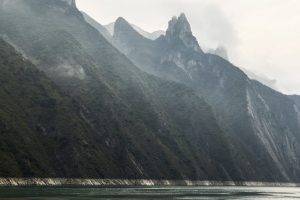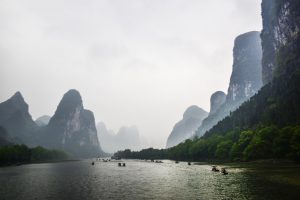 Modern China is the strangest place I have ever visited, overwhelmed with people and staggering amounts of new construction throughout the country, all obfuscated by the very controlled media.
Modern China is the strangest place I have ever visited, overwhelmed with people and staggering amounts of new construction throughout the country, all obfuscated by the very controlled media.
From the first night, upon logging onto the internet, China’s government-imposed censorship was immediately obvious. The Chinese people really only read what they are allowed to read, hear what they are told to hear… What can their citizens know for sure? It certainly makes me appreciate the privilege “freedom of speech” in our country.
You don’t even need to leave the hotel to realize China’s air pollution is horrific. Four days in Shanghai, I saw a glimpse of the sun for no more than one hour; way up the Yangtze River for 5 days, there was blue sky one afternoon for perhaps two hours. And during three days in Beijing, the sun appeared twice as an orange glow through very grey sky.
 While much of China is mountainous, its landscape is mostly masked by smog. Along the Li River, south of Guilin are miles of wonderfully-shaped 500+’ high limestone peaks formed some 200 million years ago as the Indian plate crashed into the Asian plate, creating the Himalayas, before diving under the Asian plate, forcing its underwater karst topography upward in this portion of southeastern China. This classic Chinese landscape so prevalent in their scrolls and paintings, but as a result of air pollution, together with probably some early spring atmospherics – who knows for sure – these distinctive formations were nearly obscured. You can imagine how disappointing this was for a photographer, particularly since I booked this extra leg specifically to photograph this landscape.
While much of China is mountainous, its landscape is mostly masked by smog. Along the Li River, south of Guilin are miles of wonderfully-shaped 500+’ high limestone peaks formed some 200 million years ago as the Indian plate crashed into the Asian plate, creating the Himalayas, before diving under the Asian plate, forcing its underwater karst topography upward in this portion of southeastern China. This classic Chinese landscape so prevalent in their scrolls and paintings, but as a result of air pollution, together with probably some early spring atmospherics – who knows for sure – these distinctive formations were nearly obscured. You can imagine how disappointing this was for a photographer, particularly since I booked this extra leg specifically to photograph this landscape.
As a photography trip, it was essentially a bust. The airborne pollution throughout China renders everything a grey pall, masking the elegant landscape captured by artists for centuries. But for me it was still an important trip. After seeing China as a boy, and therefore having always had more than a passing interest, I needed to see it as a man: to grasp the change, see if I could understand where China is headed, and what its incredible physical transformation over the last 25 years means to the rest of the world.
 Greater than four times the U.S.’s population in a country slightly smaller than the continental U.S., nearly half of China’s 1.4 billion people are being forced to the cities for employment, where they are housed in endless high-rise condominium blocks. Since the Chinese government owns all land in China, all commercial property is leased for 30 to 50 years, and 50 to 70 years for residential. (And as a side note, since China has retained ownership of all the world’s Pandas, any Pandas not in China have only been “loaned” out.)
Greater than four times the U.S.’s population in a country slightly smaller than the continental U.S., nearly half of China’s 1.4 billion people are being forced to the cities for employment, where they are housed in endless high-rise condominium blocks. Since the Chinese government owns all land in China, all commercial property is leased for 30 to 50 years, and 50 to 70 years for residential. (And as a side note, since China has retained ownership of all the world’s Pandas, any Pandas not in China have only been “loaned” out.)
Due to great concern over the sharp increase in China’s aging population, the government has just begun relaxing their 1-child-per-family restriction, so imagine what this will mean for this tightly packed country in another 50 years. China’s incredible real estate construction boom has led their economy for the last 15-20 years. Even now construction continues at a manic pace that is far outstripping demand. With no sign of stopping, the supply of empty buildings continues to grow, which inevitably must result in a real estate and credit crash that will reverberate around the world… a terrifying thought.
In Hong Kong’s airport, waiting to return to the U.S., I bought a book that I felt I needed to hide until we had taken off: “Why China Will Never Rule the World” [https://www.youtube.com/watch?v=xkGH0_DRBRE], by Troy Parfitt, a Canadian who has been teaching in Taiwan for the last ten years. Fluent in Mandarin, his book chronicles his two recent tours through mainland China.
 Parfitt concludes that “China’s great rise is a great illusion, that modernization in Chinese society is little more than window dressing, the welding of superficial constructs – Pepsi Signs, department stores, state-of-the-art production methods – onto an antique mindset. To argue that China is on the cusp of ruling the world is to engage in intellectual dishonesty. Unless it attempts to do so by force, China is never going to shape the world.”
Parfitt concludes that “China’s great rise is a great illusion, that modernization in Chinese society is little more than window dressing, the welding of superficial constructs – Pepsi Signs, department stores, state-of-the-art production methods – onto an antique mindset. To argue that China is on the cusp of ruling the world is to engage in intellectual dishonesty. Unless it attempts to do so by force, China is never going to shape the world.”
Whether or not he’s right, my 18 days in China left me with the distinct impression that its totalitarian government has enormous problems on its hands. Even if the upper and burgeoning middle class encompasses 400 to 500 million people, China is still stuck with nearly 1 billion people living in, or near poverty. China’s long history has never gotten beyond a succession of brutal imperial dynasties, including its current Communist government. The question is: can this ever change? Certainly forages beyond its borders will not alleviate its current problems; more likely they will fan increasing flames of discontent, as their present South China Sea explorations portend.
I am glad to have seen and sensed China again, but its problems of staggering pollution, government censorship and underlying poverty clearly don’t bode well for China, and as we are one global village, it can not bode well for us all.
Gunnar this is really excellent; very insightful, if depressing. But I think you’re right on the money. Good photography too, in spite of everything. The idea that the US is so deeply in hock to a country that could totally crash at any time is pretty scary. The old Chinese curse “May you live in interesting times” was never more apt.
Oppression, poverty and totalitarianism converge and then explode into ashes of nothing. Very nice report, Gunnar !!